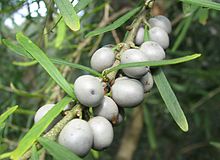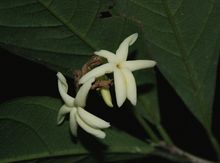Violet family
| Violet family | ||||||||||||
|---|---|---|---|---|---|---|---|---|---|---|---|---|

Grove violets ( Viola riviniana ) |
||||||||||||
| Systematics | ||||||||||||
|
||||||||||||
| Scientific name | ||||||||||||
| Violaceae | ||||||||||||
| Batsch |
The violet family (Violaceae) are a family of plants within the order of the Malpighiales (Malpighiales). The best known genus in Central Europe are the violets ( viola ).
description


Vegetative characteristics
There are annual and perennial herbaceous plants or woody plants: Half bushes , shrubs , trees and vines .
The leaves are usually arranged alternately and spirally. The mostly simple, rarely divided leaf blade has a smooth or serrated leaf margin. The stomata are anisocytic or paracytic. Many species have stipules that can be leaf-like or small.
Generative characteristics
The flowers, surrounded by two bracts, stand individually in the leaf axils or in differently structured inflorescences .
In the violet family there are both types with radial symmetry and types with zygomorphic flowers . The mostly hermaphrodite flowers are five-fold with double perianth . Often there is a spur. The five sepals are free or only fused at their base. The five petals are free and unequal. There is only one circle with five stamens . Filaments are often very short or absent. Most three (two to five) carpels have become a top permanent ovary grown. In parietal placentation there are 1 to 100 anatropic ovules in an ovary chamber . Pollination occurs by insects ( entomophilia ).
Most species form capsule fruits . However, there are also species that produce berries or nuts . In many species, the large seeds have an aril , so that they are often carried away by ants. The abundant endosperm is fleshy. The embryo is erect.
Systematics
The Violaceae family was established in 1802 by August Johann Georg Karl Batsch in Tabula Affinitatum Regni Vegetabilis , 57 under the name "Violariae". The type genre is viola . Synonyms for Violaceae Batsch are: Alsodeiaceae J.Agardh and Leoniaceae A.DC.




The family Violaceae is divided into three subfamilies: Violoideae divided into tribe and subtribe with most genera and species and the two monogeneric, species-poor Leonioideae and Fusispermoideae . It contains about 23 genera with 800 to 1000 species:
- Subfamily Fusispermoideae Hekking : It contains only one genus:
- Fusispermum Cuatrec. : The three types occur in Panama , Colombia and Peru .
- Subfamily Leonioideae : It contains only one genus:
- Leonia Ruiz & Pav .: It contains about six species in tropical South America.
- Subfamily Violoideae Beilschmied : It contains two tribes and about 21 genera:
- Tribus Rinoreeae : It contains four subtribes and 13 genera:
-
- Subtribe Hymenantherinae: It contains only two genera:
- Hymenanthera R.Br. : With a maximum of eight species.
- Melicytus J.R. Forst. & G.Forst. : With about six kinds; they are dioecious separately sexed ( diocesan ) and form berries.
-
- Subtribus Isodendriinae: It contains only one genus:
- Isodendrion A.Gray : With a maximum of 15 species, predominantly found in Hawaii.
-
-
- Subtribus Paypayrolinae: It contains about five genera:
-
- Amphirrhox explos . : It contains only two species that occur in Brazil.
- Hekkingia H.E.Ballard & Munzinger : With only one species:
- Hekkingia bordenavei H.E.Ballard & Munzinger ; it occurs in French Guiana.
- Paypayrola Aubl. : It contains about eight species that occur in tropical South America.
-
-
- Subtribus Rinoreinae: It contains about five genera:
-
- Allexis Pierre : It contains about four species that occur in tropical West Africa.
- Decorsella A. Chev. (Syn .: Gymnorinorea Keay ): It contains only one species:
- Decorsella paradoxa A. Chev. ; it occurs in Africa (Ivory Coast).
- Gloeospermum Triana & Planch. : It contains about 12 species found in tropical America.
- Rinorea Aubl. (including Alsodeia Thouars , Phyllanoa Croizat , Scyphellandra Thwaites ): It contains 160 to 270 species.
- Rinoreocarpus Ducke : It contains only one species:
- Rinoreocarpus ulei (Melch.) Ducke ; it occurs in South America.
-
-
- Tribus Violeae : It contains about ten genera:
-
- Agatea A.Gray (including Agation Brongn. ): It contains about six species found in New Caledonia.
- Anchietea A.St.-Hil. : It contains about eight species that occur in tropical South America.
- Corynostylis Mart. : It contains about four species in tropical America.
- Hybanthopsis Paula-Souza : With only one species:
- Hybanthopsis bahiensis Paula-Souza ; it occurs in Brazil (Bahia).
- Hybanthus Jacq. (Including Acentra Phil. , Clelandia J.M.Black , Cubelium Raf. ex Britton & A.Br. , Ionidium Vent. , Pigea DC. ): It contains 90 to 150 species, but is polyphyletic to that extent.
- Mayanaea Lundell : With only one species:
- Mayanaea caudata ( Lundell ) Lundell ; it occurs in Guatemala.
- Noisettia Kunth : With only one species:
- Noisettia orchidiflora (Rudge) gingins ; it occurs in Venezuela.
- Orthion Standl. & Steyerm. : With about five species.
- Schweiggeria Spreng. : With about two species in Mexico and Brazil.
- Violets ( Viola L. ) (including Erpetion Sweet , Mnemion Spach ): contains 400 to 600 species.
swell
- The Violaceae family on the AP website. (Section description and systematics)
- The Violaceae family at DELTA by L. Watson & MJ Dallwitz. (Section description)
- Yousheng Chen, Qiner Yang, Hideaki Ohba & Vladimir V. Nikitin: Violaceae , p. 138 - online with the same text as the printed work , In: Wu Zheng-yi, Peter H. Raven & Deyuan Hong (eds.): Flora of China , Volume 13 - Clusiaceae through Araliaceae , Science Press and Missouri Botanical Garden Press, Beijing and St. Louis 2007. ISBN 978-1-930723-59-7 (section description and classification)
- Toru Okuoka: Molecular phylogenetic analysis of Violaceae (Malpighiales) based on plastid and nuclear DNA sequences , In: Journal of Plant Research , Volume 121, Issue 3, 2008, pp. 253-260. doi : 10.1007 / s10265-008-0153-0
- Peter JL Mark, Alexandra H. Wortley & Carol A. Furness: Not a shrinking violet: Pollen morphology of Violaceae (Malpighiales) , In: Grana , Volume 51, Issue 3, 2012, pp. 181-193. doi : 10.1080 / 00173134.2012.679310
Individual evidence
- ↑ Violaceae in the Germplasm Resources Information Network (GRIN), USDA , ARS , National Genetic Resources Program. National Germplasm Resources Laboratory, Beltsville, Maryland.
- ↑ a b c d e f g h i David John Mabberley: Mabberley's Plant-Book. A portable dictionary of plants, their classification and uses . 3rd ed. Cambridge University Press 2008. ISBN 978-0-521-82071-4
